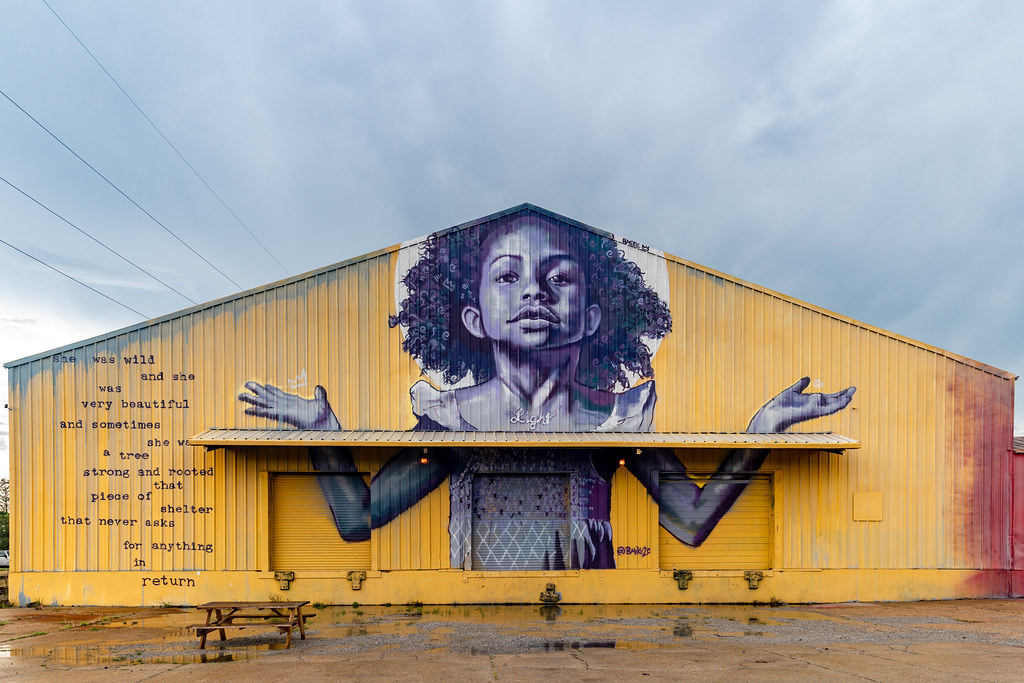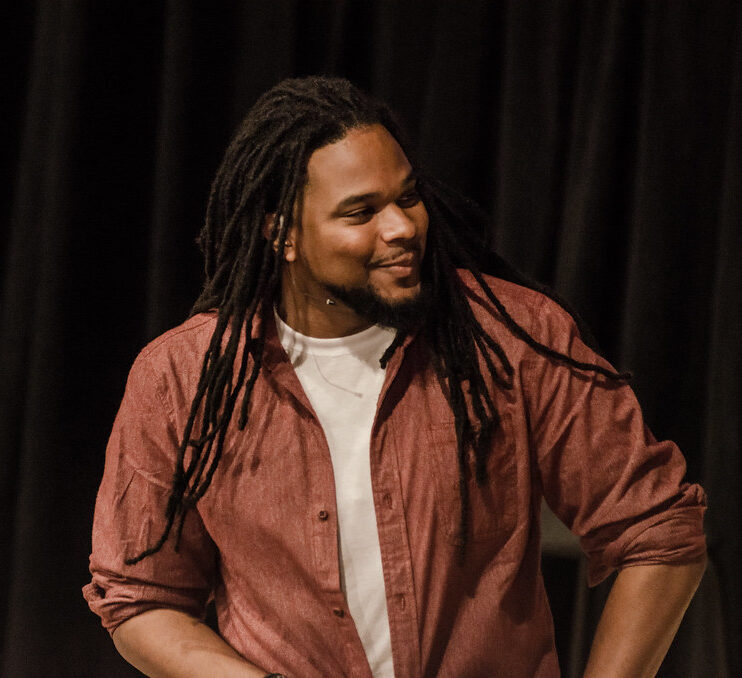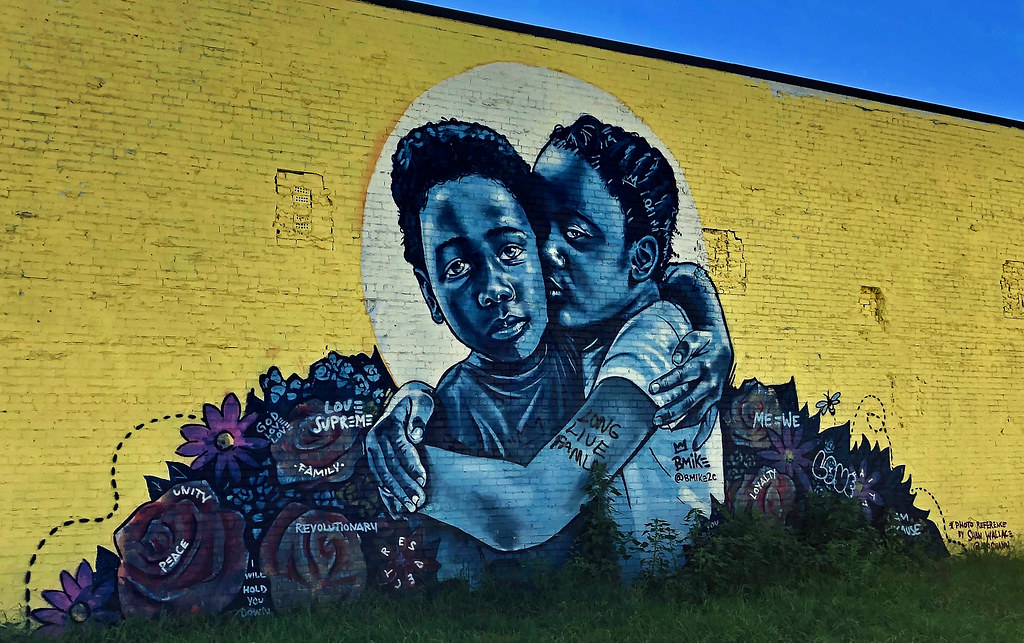If you find yourself stepping foot into the 36,000 square foot warehouse that is StudioBE, you will be overtaken by the mere enormity of it all. From the concrete floors to the tall beamed ceiling, the building swallows you up, inviting you to discover, explore, and witness. You must stretch your neck from left to right, up and down, allow your eyes to glaze over every square inch, allow yourself to focus on the details of the material, the curves of the letters, the faces, and the bodies. Massive murals of beautifully painted Black Bodies cover the walls; they are monumental; they are bold; they demand admiration and attention. It is important to know that you become a part of the space if you step into it. This space allows you to become a part of something much bigger than yourself. When you enter the doors of Studio BE, you lose your passive role. You are standing before these enormous figures that are embodying every sense of the word Power. It is not just a gallery; it symbolizes loss, pain, recovery, justice, and revolution.

BMike’s Studio BE Mural on Royal St. (Photo by: Lorie Shaull)
New Orleans’ own Brandan Odums established what would become a self-made gallery, called StudioBE, in that warehouse on Royal Street back in 2016 as a final part of his BE trilogy. Widely known as “BMike,” Odums is a Black artist, filmmaker, advocate, and mentor, advocating the rights and proper treatment of underrepresented populations. He finds his truth by breaking the rules with intention, using graffiti to question the systems in power. Odums acknowledged that art galleries didn’t view his artwork as fitting into their standards because his art needs context. The spaces in which he painted represented a bigger purpose, a bigger meaning. With his creations, he aims to lift people’s lives and passions by “putting a little paint where it ain’t.”
If you live in the Big Easy, you have likely stumbled upon one of his building-sized murals, such as the Buddy Bolden mural on Rampart St, or, more recently, his mural dedicated to the Class of 2020. Odum’s artistic abilities are reason alone to stand in awe of his work, but the pride he instills and restores in the Black New Orleans community is so beloved. With bold colors and dynamic compositions, he captures these monumental figures in a moment of joy, power, and majesty. Thus, he brings attention to his perspective of New Orleans and the artistic community, celebrating Black bodies.
Now, it is no secret the mere representation of white artists is tremendously disproportionate compared to the representation of artists of color. Despite the cultural acknowledgment and celebration that the study of art brings to our society, the institution itself diverges from this proclamation by its not-so-disguised tendency to favor white art compared to work made by artists of color. BMike pushes back against these standards and does not wait on the Art World to listen. Rather, he demands recognition, not for himself, but for his community.
Odums has paved a successful career through his massive portraits celebrating both influential figures and the everyday person. He has made it to the mainstream forefront working with brands like Nike, Spotify, Cadillac, and Red Bull, or featured on publications such as TED, TEDx, the Atlantic, as well as giving lectures at universities, such as Tulane, Xavier, Princeton, Harvard, and Stanford. He moves mountains in the art industry, proving that art is a tool that both unites and questions.

Photo of Brandan Odums, or BMike at a TEDxTalk (Photo by: tedxgno)
He paints Black Bodies powerful, audacious, and unforgivingly proud. BMike reinstates New Orleans’ underrepresented populations’ respect and acknowledgment by making the roots of their issues his canvas. BMike is weary of the Art World’s tendency to disregard art that they do not understand or relate to: “these are the artists that the gallery, the museum, they don’t know what to do with us. We didn’t really fit in any other environment.” This tension is what started his ExhibitBE project. B-Mike recruited the help of 35 street artists to help transform an overgrown, blighted foundation into this collaborative artistic experience for anyone to view, walkthrough, and respond to it. There was hardly any material that was not covered in art, important bodies painted on entire apartment walls, of influential figures such as Bob Marley, Malcolm X, Angela Davis, and much more. After just fifteen days of intense cleanup and artmaking, ExhibitBE was completed and showed publicly, bringing thousands of people into the space, to remind them they are standing in someone else’s home. StudioBE is open for school field trips to spread awareness of real issues to the youth, instilling a sense of power and ability in them, to remind them what they are capable of, that there are real issues out there that need to be addressed.
He made his artwork consistently draw attention to the location within which it exists: an abandoned apartment complex. Where are its old inhabitants now? After Katrina, it was assumed, or at least convinced, that Louisiana had recovered from the wreckage, flooding, illness, starvation, and deaths. But not all who left were able to return. ExhibitBE fights for those forgotten after Katrina; those whose abandoned homes still did not remind the state of its absent residents. Fifteen years after Katrina, the blighted homes are no longer at the forefront of New Orleans’ concerns, despite the police’s continuous surveillance of New Orleans’ homeless population.

Photo of BMike’s Supreme Love (Photo by: wiredforlego)
Odums is an inspiration for anyone looking to be inspired. He has the power to silence you stagnant as your feet are rooted in front of his works. BMike reminds us that there is a wonderful opportunity in us all, that we should push ourselves to grow forward, “there is power in the lionized characters, and there is value in the everyday person.” He so rarely identifies his work as belonging to him; his art belongs to the audience; it belongs to the greater purpose. These pieces are here to remind underrepresented populations that they are important; they are valid; and they are needed for this revolution.
 NOLAbeings
Multimedia artist Claire Bangser created NOLAbeings as a portrait-based story project that marries...
NOLAbeings
Multimedia artist Claire Bangser created NOLAbeings as a portrait-based story project that marries...
 Data corner: Adobe Suite (create a PDF, social media graphic, presentation, edit a photo and video
Data corner is where you go to work with analytics and top tech skills. It takes on everything from PERL and SQL to Canva and Sprout Social.
Data corner: Adobe Suite (create a PDF, social media graphic, presentation, edit a photo and video
Data corner is where you go to work with analytics and top tech skills. It takes on everything from PERL and SQL to Canva and Sprout Social.
